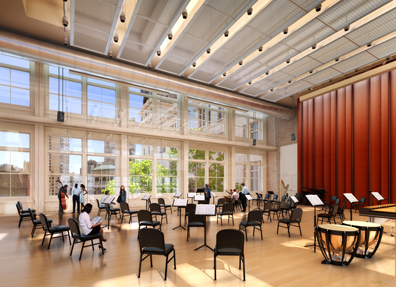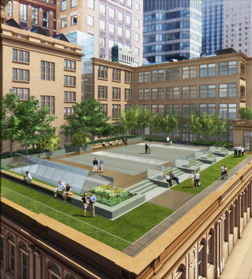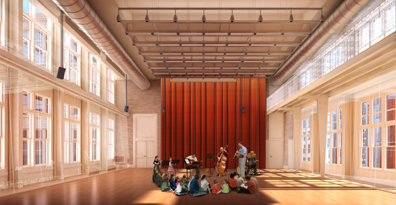Carnegie Hall Renovations Remain in Tune



Renderings by Studio Amd.
A planned renovation to bring the 120-year-old Carnegie Hall up to date with sustainable infrastructure and technology upgrades is under way at the historic building.
Carnegie Hall is listed as an individual historic landmark on both the state and national Registers of Historic places, and its exterior is a New York City landmark.
In addition to performances from professional musicians, Carnegie Hall is a venue for music education. Today, the hall is home to education and community programs developed by Carnegie Hall’s Weill Music Institute and The Academy — a program of Carnegie Hall, The Juilliard School, and the Weill Music Institute in partnership with New York City’s Department of Education.
Administrators of the hall said an extensive range of music educations have grown over time, and many of them are not suitable to take place in a concert venue.
“Since there wasn’t suitable space on-site, they frequently had to rent space off-site to accommodate the programs,” officials said. “The new spaces that will be developing on the upper floors of the building will allow them to bring many programs in-house.”
With New York-based architecture firm Iu and Bibliowicz overseeing the design, the performance venues, built in 1891, and the north and south towers, built in 1894 and 1897, will be reorganized and transformed to function as one building.
built in 1894 and 1897, will be reorganized and transformed to function as one building.
 built in 1894 and 1897, will be reorganized and transformed to function as one building.
built in 1894 and 1897, will be reorganized and transformed to function as one building.The backstage and support spaces for Carnegie Hall, which have been dispersed throughout the three buildings, will also be reorganized.
Consolidating will allow for a centralized, energy-efficient HVAC system that will output when spaces are unoccupied, and a green roof to reduce the heat-island effect. The hall’s original 450 windows are designed to allow abundant natural lighting and all rooms will be equipped with efficient lighting with occupancy sensors, according to officials.
The renovations, which also aim to improve life and safety issues, environmental comfort and accessibility, will affect 167,000 square feet, including new education spaces in both towers and the backstage areas.
The design aims to create a consistent identity for the three separate entrance lobbies, and will also include a new music education wing with 24 new music rooms for practice, teaching, and ensemble rooms with correct proportions and finishes for interior acoustic quality and exterior noise isolation.
Despite the renovations, the building’s 19th century details will remain, including its cast-iron stair railings, vaulted ceilings and door moldings, among others.
The design includes a new roof terrace first envisioned by the building’s original architect, William Tuthill, administrators said. While the building has undergone several renovations, they have mainly focused on the performance venues.
Plants on the green roof will require little water, and the roof will be equipped with a drip irrigation system. Additionally, all new restrooms in the building will be outfitted with low-flow plumbing fixtures.

The building’s hot water heaters are based on high-efficiency instantaneous recovery to provide hot water without inefficient standby losses from typical large hot water storage tanks.
The building will comply with strict VOC limits, and include janitors’ closets with deck-to-deck partitions and negative pressurization relative to surrounding spaces, as well as direct exhaust to prevent fumes and vapors from migrating.
“Carnegie Hall has long abandoned direct use of fossil fuels but is heated and cooled with steam and electricity,” officials said. “The Hall will continue to use this protocol.”
Officials say more than 75 percent of the waste produced during construction will be recycled and reused by various industries. Construction began in 2009 and is expected to complete in 2014, in coordination with Carnegie Hall’s performance and rehearsal schedules.
The three auditoriums will not be touched by the renovations, and performance calendars will be largely unaffected in future seasons.
The project is funded by a $25 million from Joan and Sanford Weill’s family foundation.
The donation brings the total funds raised to $181.5 out of the $200 million required for the project, including $56.5 million in net proceeds from bonds issued through the Trust for Cultural Resources from the City of New York and major funding pledges made from New York City and New York State.
